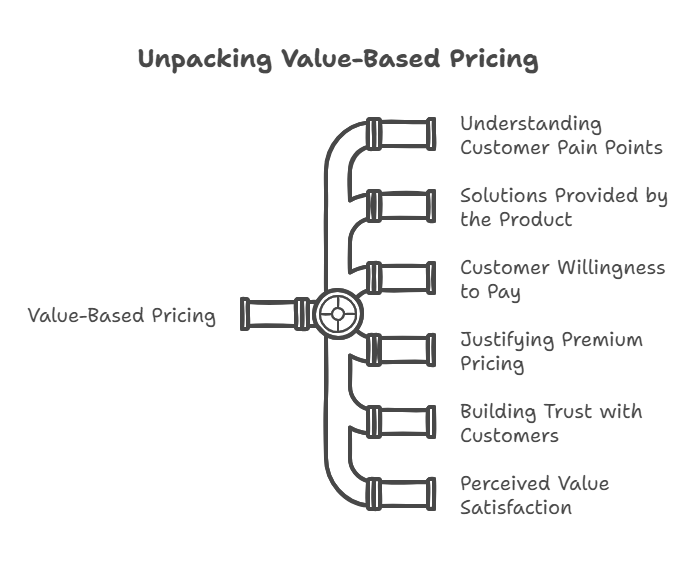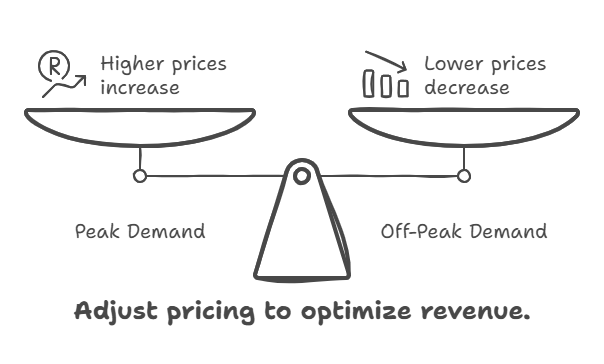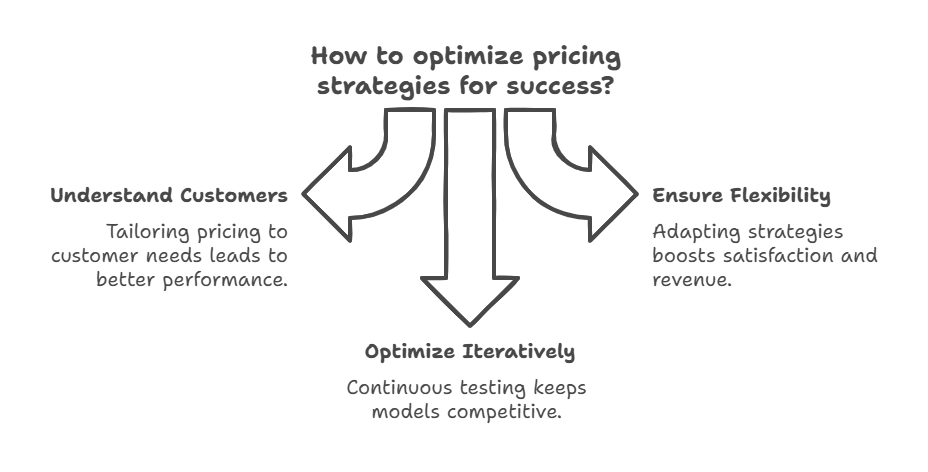How to Choose the Right Pricing Strategy for Your SaaS Product?
Discover effective strategies to optimize your SaaS pricing model and maximize revenue. Learn about value-based pricing, tiered plans, and customer insights that can drive success for your software business. Unlock the secrets to pricing optimization today!

How to Choose the Right Pricing Strategy for Your SaaS Product?
Introduction
In the hyper-competitive world of SaaS, pricing isn't just about numbers; it's a critical lever for growth and customer satisfaction. An optimized pricing strategy can be the difference between sustained profitability and stagnation. By aligning pricing with the value customers perceive and are willing to pay, SaaS companies can maximize revenue while fostering loyalty.
This blog dives into the nuances of SaaS pricing optimization, offering actionable steps, proven strategies, and advanced techniques. Whether you're refining an existing model or building one from scratch, this guide provides the tools you need to stay ahead in the ever-evolving SaaS landscape.
1. Understanding SaaS Pricing Optimization
SaaS pricing optimization is the art and science of determining the ideal price point for your software, ensuring that it aligns with both market expectations and business goals. This dynamic process requires continuous refinement based on real-time data, customer insights, and market trends.
Why is this so crucial? For one, it’s not just about setting a price that covers costs; it’s about unlocking maximum value for both the customer and the company. Misaligned pricing—whether too high or too low—can result in missed revenue opportunities or eroded brand value.
The foundation of effective SaaS pricing optimization lies in leveraging data-driven insights and market analysis. By analyzing key metrics like customer acquisition costs, churn rates, and lifetime value, businesses can make informed decisions that drive profitability. Additionally, keeping an eye on competitors’ strategies and evolving industry standards ensures your pricing stays relevant and competitive.
Want to understand how to implement this? Keep reading as we unpack the strategies, steps, and advanced techniques to craft a pricing model that works for your SaaS business.
2. Key Pricing Strategies
Value-Based Pricing
At the heart of value-based pricing is the principle that your pricing should reflect the perceived value your software delivers to customers. This approach requires an in-depth understanding of customer pain points, the solutions your product provides, and the willingness of your audience to pay. By focusing on value rather than cost, companies can justify premium pricing, build trust, and ensure customers feel they are getting their money's worth.

Dynamic Pricing
Dynamic pricing allows businesses to adjust prices in real-time based on variables like demand, usage, or market conditions. For example, during peak usage periods or high-demand seasons, prices may increase, while quieter times may see discounts to attract users. This strategy is particularly effective in maximizing revenue during periods of high demand while maintaining competitiveness.

Tiered Pricing
Tiered pricing involves offering multiple pricing packages, each tailored to different customer segments. For instance, a "Basic" package may suit small startups, while a "Professional" or "Enterprise" tier provides additional features for larger organizations. This strategy helps cater to diverse needs and ensures customers pay only for the features they value, fostering inclusivity and scalability.
Usage-Based Pricing
Under a usage-based pricing model, customers are charged based on their actual use of the product. This approach is particularly effective for services such as cloud storage, API usage, or data processing. It aligns costs with consumption, making it an attractive option for customers seeking flexibility and fairness.
Freemium Model
The freemium model offers a free version of your product to attract users, with the goal of converting them to paid plans through premium features. This strategy lowers the barrier to entry, builds a user base, and provides a platform to showcase the value of your software. Once users are engaged, offering enhanced features incentivizes them to upgrade.
Psychological Pricing
Psychological pricing leverages the psychology of decision-making to influence purchasing behavior. For example, setting a price at $99 instead of $100 creates a perception of better value. Similarly, anchoring higher-priced options alongside standard plans can make mid-tier packages appear more attractive. These subtle tactics can significantly impact conversion rates.
3. Steps to Optimize Pricing Strategy
Data Collection and Integration
Optimizing pricing starts with gathering comprehensive data. Internal data, such as sales performance, customer demographics, and usage metrics, provides insight into current patterns. External data, including competitor pricing and industry benchmarks, helps position your product competitively in the market. Integrating these data points ensures a well-rounded view of your pricing landscape.
Customer Analysis
Understanding your customers is essential to crafting an effective pricing strategy. Segment your market based on attributes such as industry, company size, or job roles. Analyze customer budgets, preferences, and pain points to design packages that align with their needs. This targeted approach enhances customer satisfaction and improves conversion rates.
Evaluate Costs and Metrics
A thorough evaluation of costs and key financial metrics ensures your pricing strategy supports profitability. Monitor essential metrics like Customer Acquisition Cost (CAC), Customer Lifetime Value (CLTV), churn rate, and Monthly Recurring Revenue (MRR). These indicators help determine the sustainability and efficiency of your pricing model.
Testing and Feedback
Experimentation is key to finding the optimal pricing strategy. Conduct A/B testing to compare different models and assess their impact on conversion rates. Gather direct customer feedback through surveys and interviews to refine your approach. Iterative testing ensures your pricing remains responsive to market and customer needs.
Communicating Value
Pricing should reflect the value your product delivers, and this message must be clear to your audience. Develop marketing materials that highlight key benefits and return on investment (ROI). Equip your sales team with the tools to articulate this value effectively, ensuring customers understand the rationale behind the pricing and its alignment with their goals.
4. Advanced Strategies for SaaS Success
Price Localization
Global markets present diverse economic landscapes, purchasing powers, and cultural preferences. Price localization involves tailoring your pricing to align with these differences. For instance, adjusting prices based on currency, regional demand, or average income levels ensures your product remains accessible and competitive in various regions. This strategy can also include offering localized support and marketing to enhance customer trust and satisfaction.
Customer-Centric Customization
Personalization is key to enhancing customer experience. Customer-centric customization involves creating tailored offers based on individual behavior, preferences, or usage patterns. This approach may include personalized discounts, customized feature bundles, or exclusive add-ons. By making customers feel understood and valued, businesses can increase conversion rates and foster long-term loyalty.
Subscription Renewal Incentives
Retaining customers is as critical as acquiring new ones. Subscription renewal incentives, such as loyalty discounts, early renewal bonuses, or flexible payment terms, encourage customers to stay committed to your product. Additionally, providing consistent value through updates, support, and engagement strengthens customer relationships, reducing churn and boosting lifetime value.
5. Real-Life Applications and Case Studies
Examples of Successful Implementation
- Slack’s Tiered Pricing Approach: Slack leverages a tiered pricing model that caters to various business sizes and needs. By offering packages with differentiated features, they effectively serve startups and enterprises alike, ensuring maximum market penetration.
- Spotify’s Price Localization Strategy: Spotify’s pricing adapts to regional markets, accounting for differences in currency and purchasing power. Their student discounts and family plans also demonstrate how targeted offers can drive adoption in specific demographics.
- AWS’s Usage-Based Model: Amazon Web Services excels with a usage-based pricing strategy. Customers pay only for what they use, whether it’s storage, processing, or other services, making it an appealing choice for businesses of all sizes.
Insights and Lessons Learned
- Customer Understanding is Paramount: Success stories highlight the importance of deeply understanding customer needs and behaviors. Companies that tailor their pricing to these insights consistently outperform competitors.
- Flexibility Drives Success: The ability to adapt pricing strategies—whether through localization, customization, or dynamic adjustments—can significantly boost customer satisfaction and revenue.
- Iterative Optimization is Key: Continuous testing and refinement of pricing strategies are vital. Even the most successful companies regularly evaluate and tweak their models to maintain competitiveness and relevance.

By applying these advanced strategies and learning from industry leaders, SaaS businesses can position themselves for sustainable growth and success in a competitive market.
Conclusion
Recap of the Importance of a Well-Optimized Pricing Strategy
A well-optimized pricing strategy is not just about maximizing profits—it’s a delicate balance between achieving financial sustainability and delivering exceptional value to customers. The strategies discussed, from value-based pricing to advanced techniques like price localization, demonstrate the profound impact thoughtful pricing can have on customer satisfaction, retention, and overall business growth. By leveraging data-driven insights and continuously adapting to market dynamics, SaaS companies can remain competitive and resilient in an ever-evolving landscape.
Call-to-Action
Now is the time to take a closer look at your pricing models. Assess their alignment with customer needs, market trends, and business goals. Experiment, analyze feedback, and refine your strategies using the actionable tips provided in this guide. Remember, the journey to optimized pricing is iterative and ongoing.
Further Reading and Resources
In-Depth Understanding
- "The Art of SaaS Pricing Optimization" by Revology Analytics Read here
- Effiqs’s "Complete Strategy Guide to B2B SaaS Price Optimization" Explore here
Cited Articles for Extended Learning
- "What is SaaS Pricing Optimization?" by PayPro Global Learn more
- "SaaS Pricing Strategy" by Penfriend.ai Check it out
By diving into these resources, you can expand your knowledge and stay informed on best practices for SaaS pricing optimization. Implement what you learn, and watch your SaaS business thrive.
